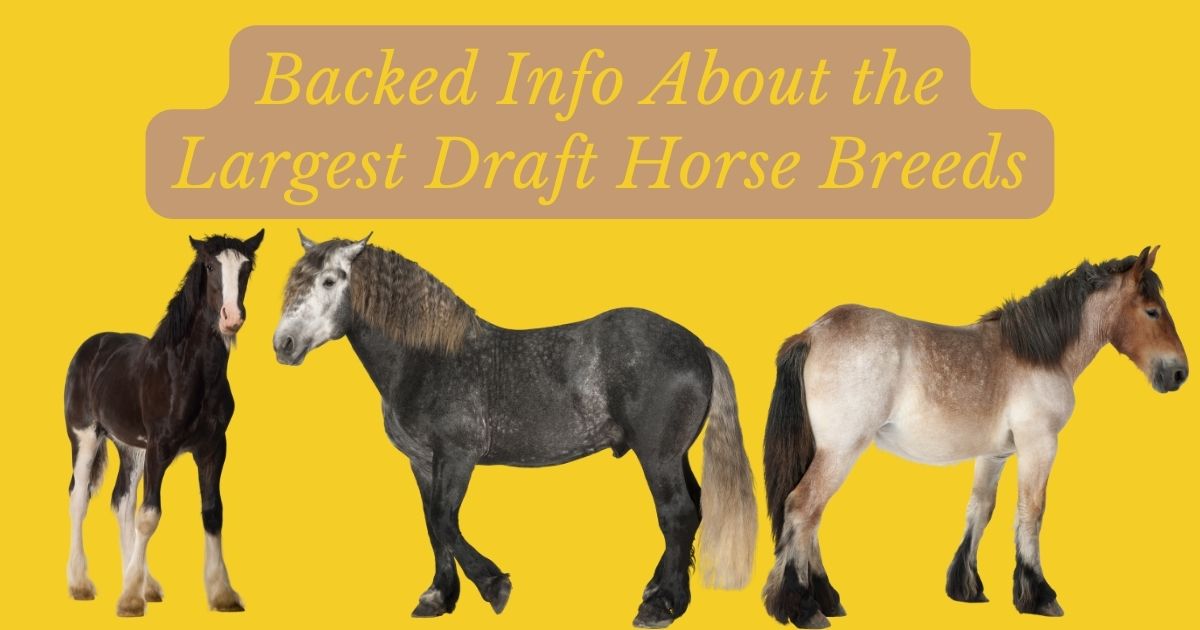Draft Horses
Draft horses are the world’s largest horses. The largest draft horse breed is for work, such as logging, plowing, or hauling big loads on sleds or carriages. They undergo breeding for their size and strength and are primarily for lifting heavy loads.
Some draft horses make decent riding horses, while most are for pulling objects like wagons. In western Kazakhstan, people initially brought horses under control more than 5,000 years ago.
The Ten Largest Draft Horse Breeds
The largest breed of draft horse production has been for hundreds of years to assist people in various work activities. These wonderful creatures have been of immense help to humankind throughout history. Their contributions range from pulling chariots to riding in parades and competing in races.
Let’s take a look at some of the largest horse breeds in the world, their rich histories, and the distinguishing traits that set them apart from one another:
Shire
Height: 17 to 19 hands (1.73 to 1.93 meters)
Weight: 1,800 to 2,400 pounds (816.5 to 1,088.6 kilograms)
Country of origin: England
Life expectancy: 25 to 30 years
Average price: $2,000 to $20,000
The Shire is the breed of horse that is currently the most popular in the world, and it is famous for its lofty, muscular form and feathery legs. It is one of the biggest horses in the world. It also has a laid-back attitude, making it one of the horses with the most desirable qualities. The typical colors for dogs of this breed include chestnut, bay, grey, black, and brown.
It has a rich history, the most prominent part of which was when they used it to move enormous carts filled with ale from breweries to residences. But in addition to that, it has been used for many other things, such as farming, riding, and battling on battlefields.
Even today, farmers with smaller farms are finding that this breed of horses is a more environmentally friendly alternative to tractors. Shire horses have historically ranked among the strongest breeds, which may be why they utilize them to complete strenuous activities.
We believe that in the 1920s, two Shires were responsible for transporting a load that weighed more than 40 tons (36,287.4 kilograms)! However, because of the ever-increasing mechanization of transportation equipment, people have shifted their preference toward the more sophisticated means of carriage, which has resulted in a significant reduction in the number of Shire horses.
However, there is still some hope for this breed of horses, which is on the verge of extinction, owing to organizations such as the American Shire Horse Association. As a result of the efforts of those involved, Shire horses are gradually beginning to make a comeback.
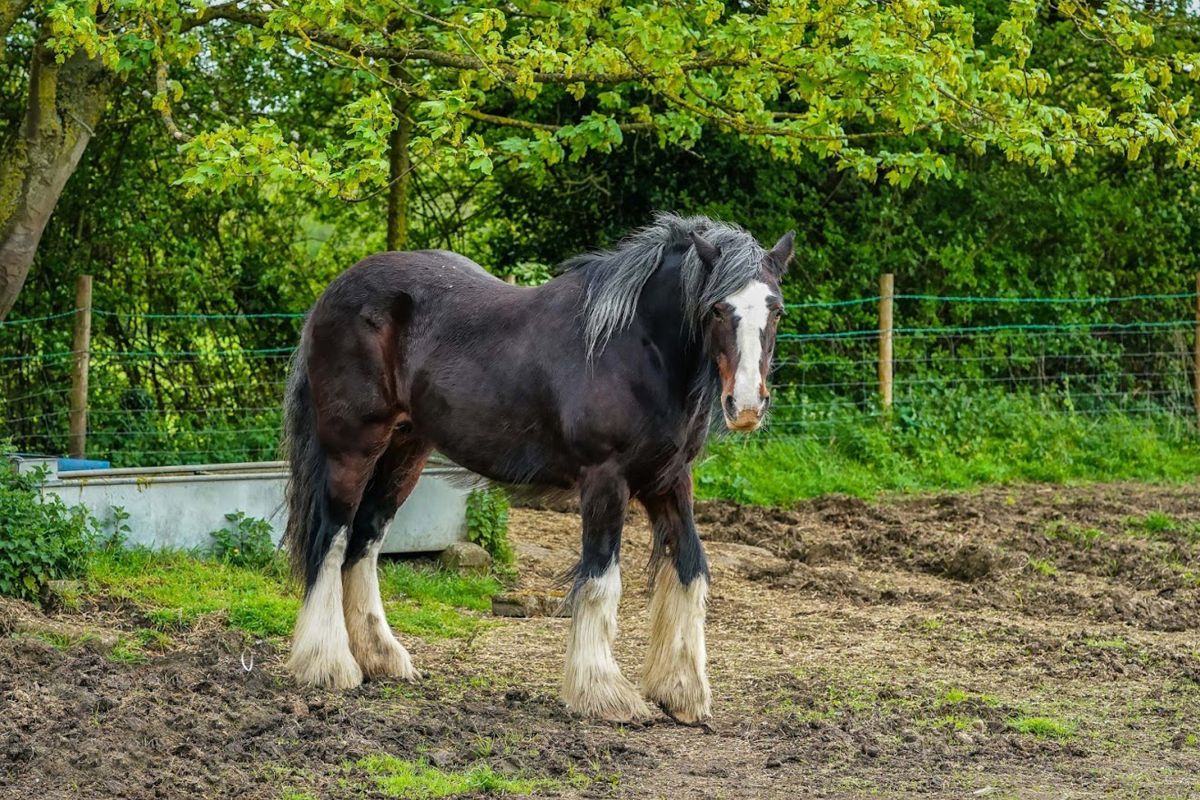
Clydesdale
Height: 16 to 18 hands (1.63 to 1.83 meters)
Weight: 1800 to 2000 pounds (816.5 to 907.2 kilograms)
Country of origin: Scotland
Life expectancy: 20 to 25 years
Average price: $2,500 to $5,000
Clydesdales are famous for their high-stepping gait and are marginally smaller than Shires. The majority of Clydesdales have a coat that is a dark bay in color with white markings on the face, feet, and legs. You can also find markings beneath the belly of some horses. Color variations of the Clydesdale horse include black, grey, and chestnut.
This horse breed is famous for its great trainability and peaceful demeanor, contributing to its widespread popularity. The legs have a silky, feathery texture, the forehead is large, and the neck is long and arched. These are some of the noticeable traits.
We put to service these lovely creatures on farms and in other contexts that make use of their capabilities because of their calm demeanor and high level of activity. In addition, these horses are for exhibitions and parades because of the striking appearance characterized by the white feathering on their hooves. Read our article and find out Shire Horse vs. Clydesdale – The DIFFERENCE.
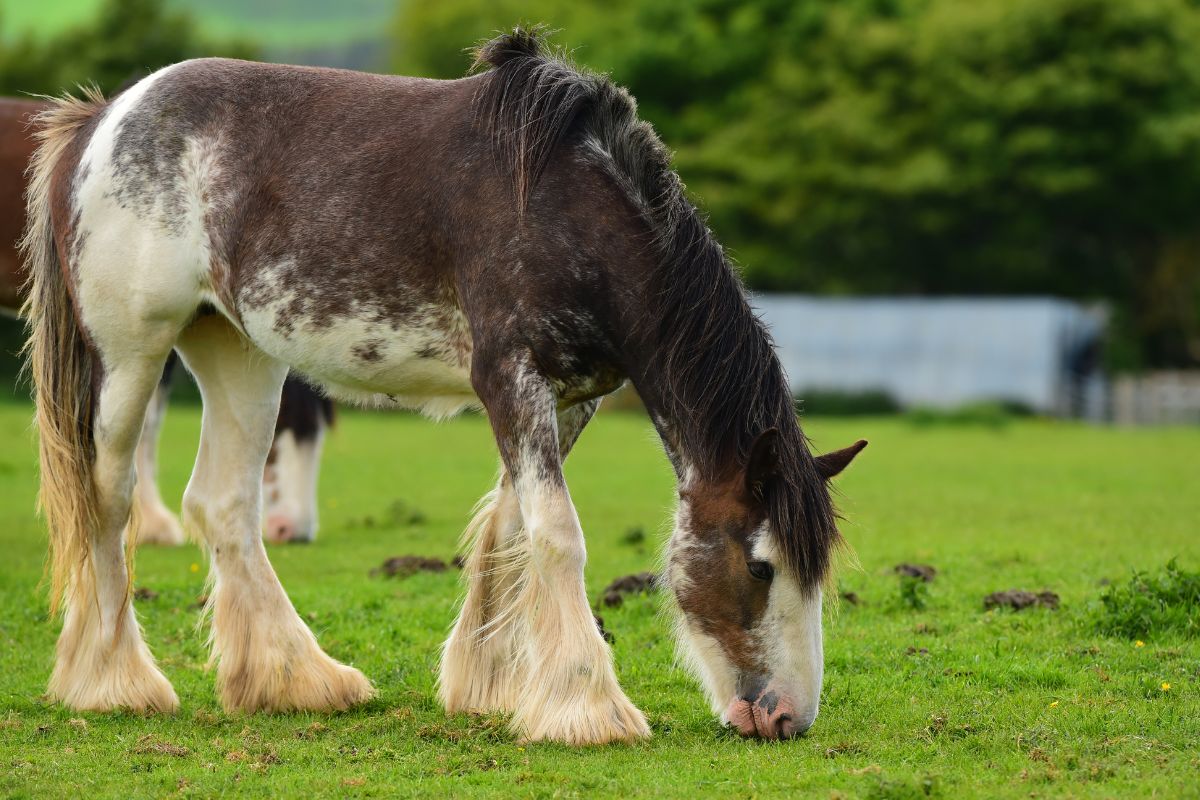
Percheron
Height: 15 to 19 hands (1.53 to 1.93 meters)
Weight: 1,900 to 2,000 pounds (861.8 to 907.2 kilograms)
Country of origin: France
Life expectancy: 25 to 30 years
Average price: $1,000 to $10,000
Did you know that at one time, people thought Percheron horses were the tallest horses in the world? You got that right! Percherons could reach a height of up to 19 hands (1.93 meters) in their original form.
However, the mating of Percherons with lighter horses, such as Arabians, had a considerable impact on the size and strength of these equines due to the offspring of these two breeds. On the other hand, there is a silver lining; it also contributed to the sophisticated way they presented themselves.
In modern times, Percherons are for a wide variety of equine activities, including riding, horse shows, and parades. They are also some of the most intercrossed horses, which is especially common when pairing a larger horse with a smaller horse.
The tenacity, eagerness to toil, and adaptability to harsh environments are the characteristics for which this type of horse is most known. The majority of a Percherons coat is either black or gray.
The country in which they breed them significantly impacts their size. For example, those they produce in France or the United States tended to be larger than those of similar breeds in Great Britain.
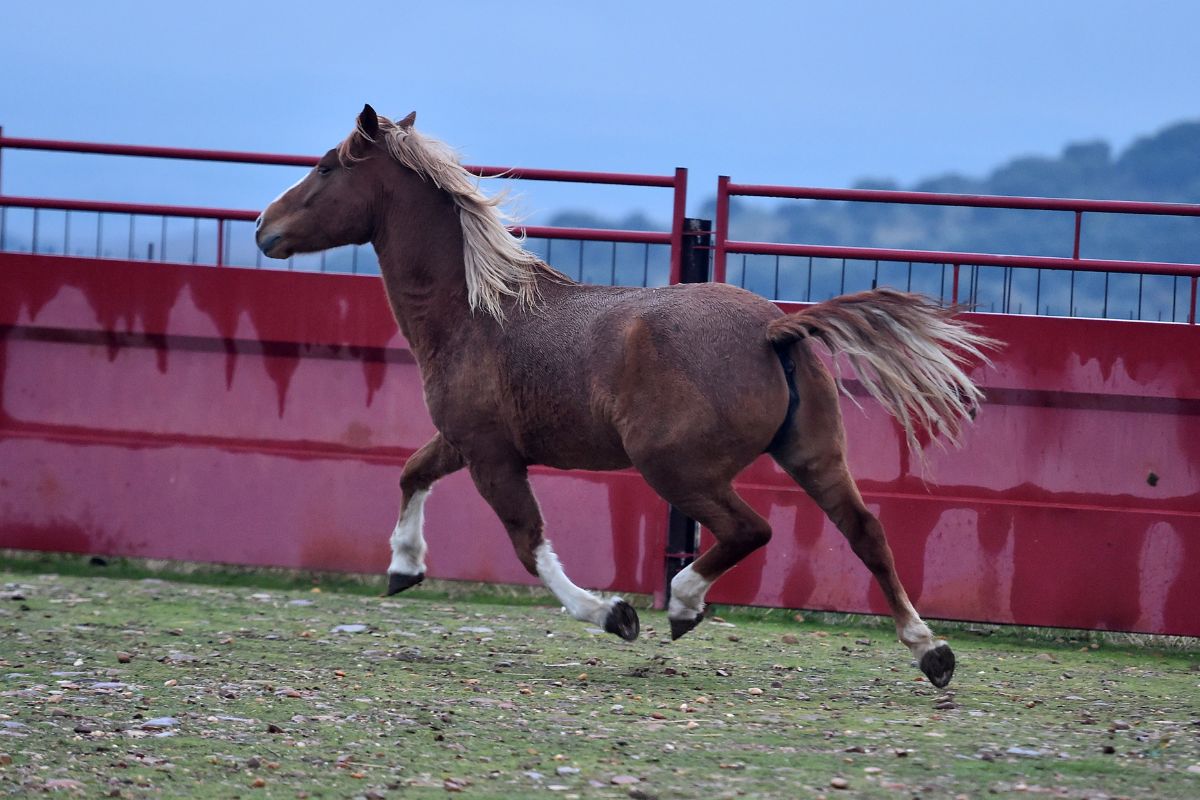
Belgian Draft
Height: 15 to 18 hands (1.53 to 1.83 meters)
Weight: 1,800 to 2,200 pounds (816.5 to 997.9 kilograms)
Country of origin: Belgium
Life expectancy: 18 to 24 years
Average price: $5,000 to $10,000
One of the types of horses that got traditional utilization in agricultural settings is the giant Belgian Draft horse, which was once known as the Flanders Horse. In modern times, the horse is helpful in various contexts, including agricultural labor and the pulling of carts, as well as in riding competitions and displays.
Even though Belgian Drafts have feathered hooves like Shires and Clydesdales, the necks of Belgian Drafts are much shorter and more muscular than those of the other two breeds. Shires and Clydesdales have long, graceful necks.
In addition, most of them have a coloring that is either bay, roan, sorrel, or chestnut. In general, Belgian Drafts are smaller than many horse breeds classified as larger; however, there have been reports of some of these horses reaching sizes comparable to that of Shire horses.
The Brooklyn Supreme, a huge horse that stood up to 19 hands (1.93 meters) tall and weighed more than 3,000 pounds (1,360.8 kilograms), is the most famous giant horse.
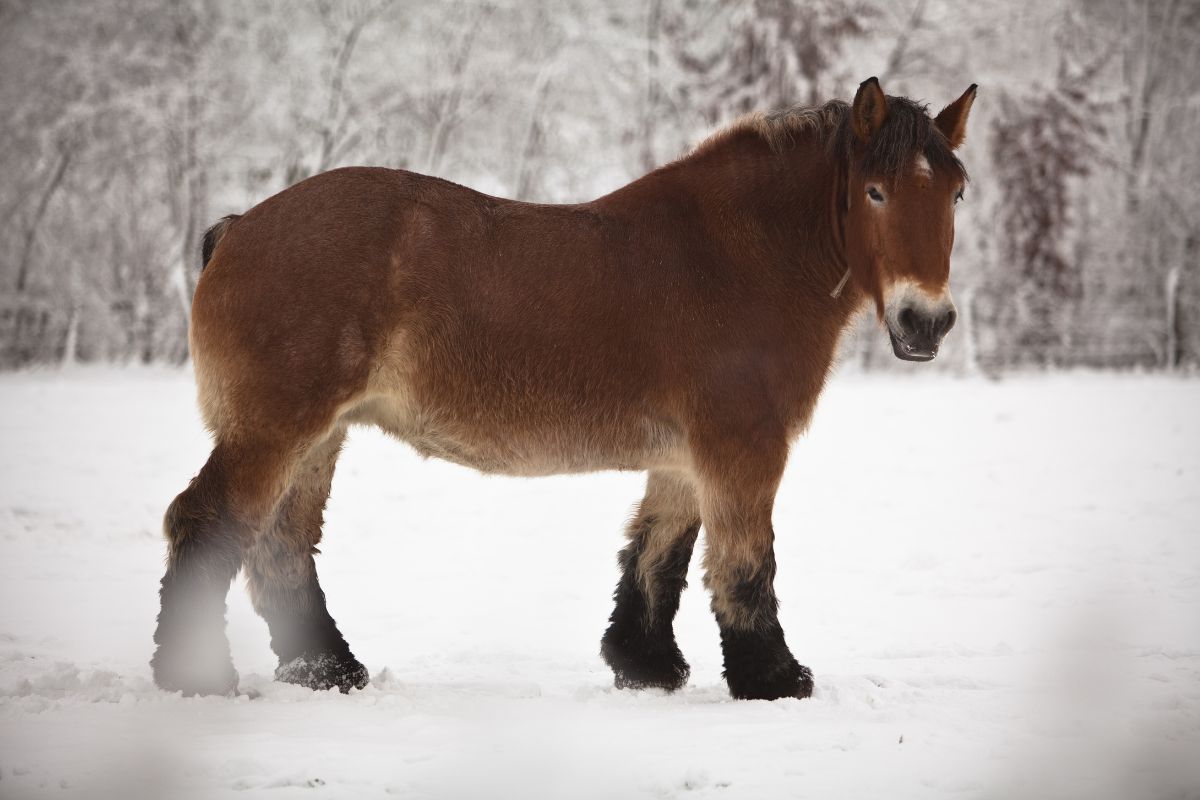
Dutch Draft
Height: 15 to 17 hands (1.53 to 1.73 meters)
Weight: 1,500 to 1,700 pounds (680.4 to 771.1 kilograms)
Country of origin: The Netherlands
Life expectancy: 15 to 20 years
Average price: $4,000 to $7,000
The Dutch Draft horse breed is one of the most endangered types of equine, but it consistently ranks high among the world’s largest horses. It is a hybrid of the Belgian Draft and the Ardennes horse, and it was one of the most popular equine breeds used in traditional horse sports.
In the course of their history, Dutch Drafts have proven to be exceptionally useful on farms, where they hauled extremely hefty loads for extended periods. They have a generally calm disposition despite their high level of intelligence. It is also common knowledge that these draft horses walk more slowly than other draft horses.
The majority of Dutch Drafts horses breeds have coats that are chestnut, grey, or bay in color. In addition, they have a torso that is generally muscular, a wide neck, short legs, and a vertical head. In addition to that, they inherited their gorgeous feathered hooves from their ancestors who lived in Belgium.
Suffolk Punch
Height: 16 to 18 hands (1.63 to 1.83 meters)
Weight: 1,900 to 2,200 pounds (861.8 to 997.9 kilograms)
Country of origin: England
Life expectancy: 25 to 30 years
Average Price: $5,000
You can trace the origin of the Suffolk Punch back to the county of Suffolk in England, which has been famous as the breeding ground for draft horses since the 1600s. It is the oldest native horse breed in Great Britain and whose breeding was for agricultural work in particular.
The number of Suffolk horses experienced a steep decline beginning in the late 1940s and came dangerously close to extinction throughout the 1950s. This declining trend has persisted throughout the years. Only a handful of these horses are now surviving; the American Livestock Breeds Conservatory classifies their status as “important.”
Chestnut is the only acceptable color for Suffolk Punch horses. A tiny percentage has white markings on the face and legs, although this is highly uncommon. The legs are somewhat short, and musculature and bone are dense. We refer to the horse as the “Suffolk Punch” due to its generally rounded form, which is where the name comes from.
Some of Suffolk’s most notable qualities were her intelligence, her submissive demeanor, and her willingness to put in hard effort. Additionally, compared to other draft horses, this breed has a lower caloric intake requirement, making it simpler to domesticate.
American Cream Draft
Height: 15.1 to 16.3 hands (1.534 to 1.656 meters)
Weight: 1,600 to 1,800 pounds (725.7 to 816.5 kilograms)
Country of origin: United States of America
Life expectancy: 25 to 30 years
Average price: $2,500 to $100,000
The only historic draft breed that underwent breeding in the United States that is still around today is the American Cream Draft. It has a lovely cream coat, gorgeous amber eyes, and a magnificent white mane and tail, which add to its overall beauty. You can find white markings on some breeds.
This horse exhibits the classic physical characteristics of a draft animal, including a broad chest, a short and powerful back, and well-muscled hindquarters. Its applications are in driving, displays, riding, and agricultural activities. Along the same lines as the Suffolk Punch, the American Cream Draft is an essential breed.
Even though the number of recognized breeds has grown over the years, the situation is still not at a stage where we can say it is safe.
Australian Draught
Height: 16 to 17.2 hands (1.63 to 1.75 meters)
Weight: 1,320 to 1,980 pounds (598.7 to 898.1 kilograms)
Country of origin: Australia
Life expectancy: Australia
Average price: $1,000 to $25,000
The Shire, the Clydesdale, the Percheron, and the Suffolk Punch were the pure draught breeds used in the breeding process to create the Australian Draught. The Australian Draught is a breed of horse traditionally utilized for draught work due to its powerful build, resistance to disease, and even-tempered demeanor.
However, in modern times, this horse is for various activities, including riding and working on farms. Because of the combination of several distinct horse breeds that went into the creation of this breed, the coat can be a variety of colors, including white, black, gray, roan, and brown, among others.
Recently, they added the breed to the blood of the Belgian Draft, which has increased the number of colors and characteristics seen within the species.
The body is robust and hardy, with clear, alert eyes, a medium-length neck, well-muscled shoulders, a broad chest, hips, and hindquarters, and light, medium-feathered legs. Other notable physical characteristics include clear, alert eyes, a medium-length neck, well-muscled shoulders, a medium-length neck, and wide hips and hindquarters.
Boulonnais
Height: 15.1 to 17 hands (1.534 to 1.73 meters)
Weight: 1,250 to 1,650 pounds (567 to 748.4 kilograms)
Country of origin: France
Life expectancy: 20 to 25 years
Average price: $6,000 to $12,000
The Boulonnais is the most refined of all the sketches and is also known as the White Marble. It is one of the breeds that have been present for quite some time, with its origin reaching back to the periods when no crusades were taking place. The calvary of Julius Caesar is to have left behind some horses of this type in England before they invaded the country.
Some believe that you can trace this breed back to those horses. Throughout their history, Boulonnais horses have undergone improvisation. This is through breeding with other breeds, including the Arabian, Andalusian, and Spanish Barb. The resulting breeds have, in turn, crossbred with one another to produce different types of draft horses.
Although most Boulonnais horses are gray, some modern breed examples have black or chestnut coats. Their heads are short and unique, with a broad forehead and prominent ears that are relatively tiny in size. The legs are substantial and powerful, with clean joints, and the neck is big, muscular, and gracefully arched.
The fact that these horses are so big does not prevent them from being manageable. Because they are kind, lively, and full of energy, they make fantastic companions.
Jutland
Height: 15 to 16.1 hands (1.53 to 1.636 meters)
Weight: 1,430 to 1,760 pounds (648.6 to 798.3 kilograms)
Country of origin: Denmark
Life expectancy: 25 to 30 years
Average price: $3,000 to $30,000
One of the most popular horse breeds in the world, Jutland gained its name from the well-known Jutland Peninsula, and you will frequently see it in movies and festivals. Because it is quiet, mild, docile, and active, it is much simpler for humans to domesticate and work with than other animals.
Most horses have a chestnut coat, but a few come in various colors, such as bay, black, gray, or roan. There is a possibility that some have white marks on their face and legs.
Jutland has a convex face profile, low and flat withers, short and arched neck, broad chest, straight shoulders, and a short, muscular back. In addition to these distinctive hues, Jutland has additional unique physical traits, such as colors.
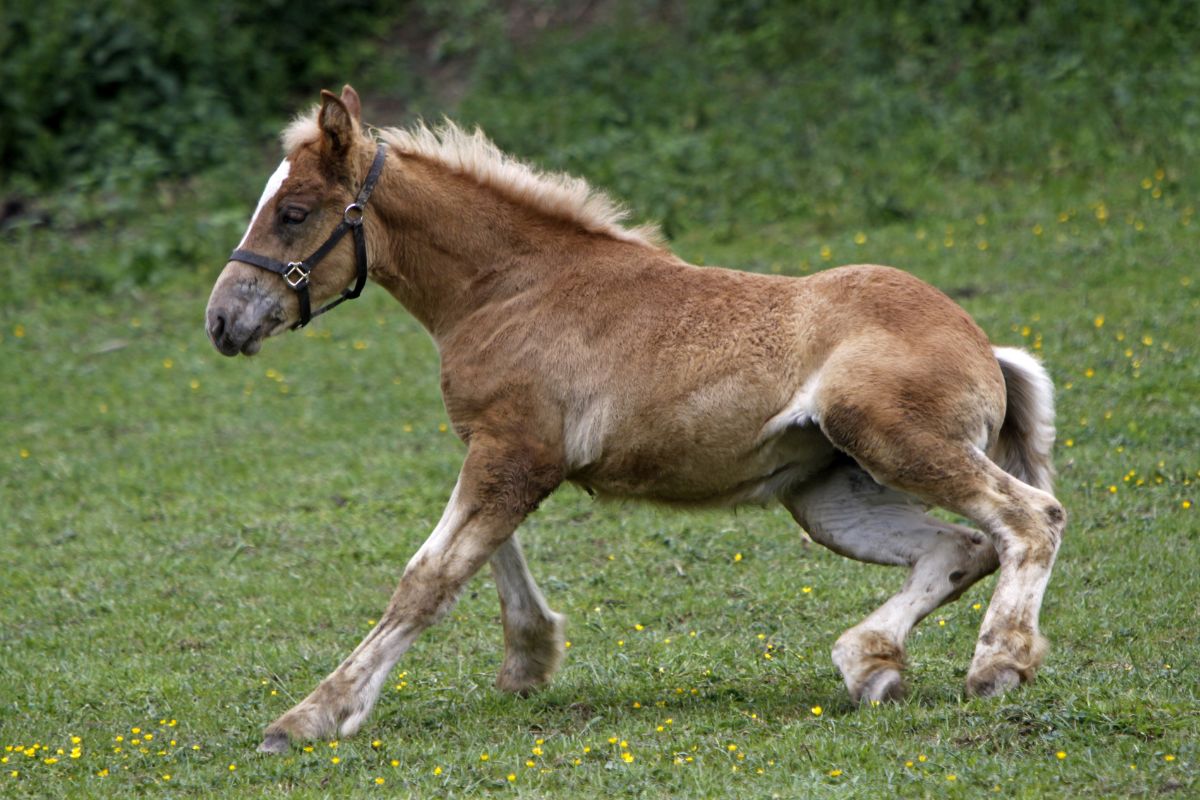
What Determines the Size of a Horse?
Since horses have been around for centuries, a norm has been in place virtually simultaneously. The withers, also known as the ridge that runs between the horse’s shoulder blades, determine a horse’s height. Take this measurement from the ground up to the highest point on the withers.
You measure most horses’ height at the highest point of the withers, determined by measuring from the ground to the highest point. As you are probably aware, you measure the height of a horse in hands, and one hand is equal to a distance of four inches. According to this definition, a person must have a height of at least 14.2 hands (1.44 meters) to consider a horse or pony.
The largest horses are typically the ones with the most height. This implies that you must be familiar with the method used to measure a horse’s height to determine whether or not the horse belongs to a group of large breeds. We express the length of a horse in hands, sometimes abbreviated as “hh” or “h.”
According to the statistics, one hand of an adult guy is equivalent to four inches. If someone tells you that a horse’s height in hands and inches is 16.4, for example, the horse has a height of 16 inches (0.406 meters) and 4 inches (0.102 meters). The world’s largest horse breeds’ average height is between 16.2 and 19 hands (1.65 and 1.93 meters).
In days gone by, you determine the height of a horse by looking at its hands instead of a ruler. One would begin by positioning one hand next to the horse’s hoof on the ground and the other hand above it. Next, one would take the first hand from its initial position and put it over the second.
You would repeat this process until one hand rested on the horse’s wither. But things have evolved over the years, and now many various tools can measure the height of a horse more quickly and correctly than ever before. The horse measuring stick is the instrument that has shown to be the most successful.
It would be best if you held the position perpendicular to the ground next to the horse, and you should level it with the highest point of the horse’s withers. Make a note of your measurement here. If the device that you are using can only measure in inches, divide the reading that you get by 4.
We’ve Got You Covered
Therefore, you can approximate the height of the colt at maturity at any time by taking the current height, dividing it by the percentage maturity the colt is according to age, and then multiplying the result by 100. In addition, the length of the horse’s legs attains full development by the age of one year, and a mature horse will often be twice as tall as the length of his legs.
